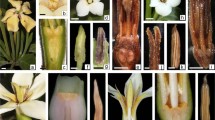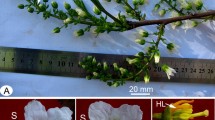Summary
The family Ericaceae is considered to be mostly hermaphroditic and only in a few cases unisexual or dioecious. Five Argentinian species (Gaultheria antarctica Hook, f., G. caespitosa P. et E., G. phillyreaefolia (Pers.) Sleumer, G. tenuifolia (Phil.) Sleumer and Pernettya insana (Molina) Gunckel), previously described as hermaphroditic, were found by us to have two types of flowers: female and male. Female flowers have both a rudimentary androecium with stamens, in which the anthers are small, collapsed and without pollen grains or are reduced to filaments only, and a perfect gynoecium with well-developed ovules filling the carpel locules. The stigma is expanded and of the wet, papillate type, with copious to slight secretion. The stigma protrudes above the anthers. Male flowers have a well-developed androecium included within the corolla and a reduced gynoecium. Anthers are as long as the filaments, except in G. caespitosa. Pollen is shed as tetrads which are 100% viable. Ovule development ranges from total absence, passing through aborted ovules of various sizes to apparently normal ones. Stigmata are neither expanded nor papillate, except in Pernettya insana. Only in two species do the style and stigma extend beyond the level of the anthers. Heterostyly does not occur in any of the five species studied. Functional dioecy thus characterizes the five species considered and is reported for the first time in the genus Gaultheria.
Similar content being viewed by others
References
Aalders LE, Hall IV (1963) The inheritance and morphological development of male-sterility in the common lowbush blueberry, Vaccinium angustifolium Ait. Can J Genet Cytol 5:380–383
Alexander MP (1969) Differential staining of aborted and nonaborted pollen. Stain Technol 44:117–122
Artopoeus A (1903) Über den Bau und die Öffnungsweise der Antheren und die Entwicklung der Samen der Ericaceen. Flora 92:309–345
Bentham G, Hooker JD (1876) Ericaceae. In: Genera plantarum, vol II/2. Lovell Reeve/Williams & Northgate, London, pp 577–604
Clay K, Ellstrand NC (1981) Stylar polymorphism in Epigaea repens, a dioecious species. Bull Torrey Bot Club 108:305–310
Cocucci A (1969) El proceso sexual en angiospermas. Kurtziana 5:407–423
Cocucci A (1980) Precisiones sobre la terminología sexológica aplicada a las angiospermas. Bol Soc Arg Bot vol XIX/1–2:75–81
Crowe L (1964) The evolution of outbreeding in plants. I. The angiosperms. Heredity 19:435–457
Darwin C (1877) The different forms of flowers on plants of the same species. Murray, London
Drude O (1891) Ericaceae. In: Engler A, Prantl K (eds) Die natürlichen Pflanzenfamilien, vol IV/1–2. Engelmann, Leipzig, pp 15–65
Emberger L (1960) Les végétaux vasculaires. In: Chadefaud M, Emberger L (eds) Traité de botanique systématique, vol II/2. Masson, Paris, pp 1291–1299
Frankel R, Galun E (1977) Pollination mechanisms, reproduction and plant breeding. (Monographs on theoretical and applied genetics, vol 2) Springer, Berlin Heidelberg New York
Franklin DA (1962) The Ericaceae in New Zealand (Gaultheria and Pernettya). Trans R Soc N Z Bot 1:155–173
Fryxell P (1957) Mode of reproduction of higher plants. Bot Rev 23:135–233
Gray A (1876) Heteromorphism in Epigaea. Am J Sci 3:74–76
Hall IV, Aalders LE, Wood GW (1966) Female sterility in the common lowbush blueberry, Vaccinium angustifolium Ait. Can J Genet Cytol 8:296–299
Halsted BD (1891) Notes upon Epigaea repens. Bull Torrey Bot Club 18:249–250
Heslop-Harrison Y (1981) Stigma characteristics and angiosperm taxonomy. Nord J Bot 1:401–420
Heslop-Harrison Y, Shivanna KR (1977) The receptive surface of the angiosperm stigma. Ann Bot (London) 41:1233–1258
Hitchcok C, Cronquist A (1973) Flora of the Pacific Northwest. An illustrated manual. University of Washington Press, Seattle, Wash
Holmgren PK, Keuken W, Schofield EK (1981) Index herbariorum, 7th edn. Regnum Veg 106:1–452
Hutchinson J (1959) The families of flowering plants. (Dicotyledons, vol 1) Oxford University Press, London
Hutchinson J (1964) The genera of flowering plants, vol 1. Oxford University Press, London
Ikuse M (1954) The presence of viscin threads among pollen grains in Phyllodoceae, etc. of Ericaceae. J Jpn Bot 29:146–148
Kahn TL, De Mason DA (1986) A quantitative and structural comparison of Citrus pollen tube development in cross-compatible and self-incompatible gynoecia. Can J Bot 64:2548–2555
Lewis D (1942) The evolution of sex in flowering plants. Biol Rev 17:46–67
Linskens H (1975) The physiological basis of incompatibility in angiosperms. Biol J Linn Soc 7 [Suppl 1]:143–152
Matthews J, Taylor G (1926) The structure and development of the stamen in Erica hirtiflora. Trans Proc Bot Soc Edinburgh 29:235–242
McLean R, Ivimey-Cook C (1956) A textbook of theoretical botany, vol 2. Longmans, Edinburgh
Meehan T (1868) Variations in Epigaea repens. Proc Acad Nat Sci Philadelphia 20:153–156
Michaux A (1889) Extracts from the Journal of André Michaux written during his travels in the U.S. and Canada, 1785–1796. Proc Am Philos Soc 26:1–145
Moore DM (1983) Flora of Tierra del Fuego. Nelson, Oswestry
Palser BF (1951) Studies of floral morphology in the Ericales. I. Organography and vascular anatomy in the Andromedeae. Bot Gaz (Chicago) 112:447–485
Palser BF (1958) Studies of floral morphology in the Ericales. IV. Observations on three members of the Gaultherieae. Trans Ill State Acad Sci 51:24–34
Rendle A (1925) The classification of flowering plants, vol 2. Cambridge University Press, London
Ross MD (1969) Heteromorphism and the evolution of dioecy in Epigaea repens. Heredity 24:162–165
Ross MD (1982) Five evolutionary pathways to subdioecy. Am Nat 119:297–318
Schultze-Motel W (1964) Ericaceae. In: Engler A (ed) Syllabus der Pflanzenfamilien, vol 2. Borntraeger, Berlin, pp 381–389
Sleumer H (1952) Las Ericáceas argentinas. Lilloa 25:515–556
Sleumer H (1966) Ericaceae. In: Van Steenis CGGJ (ed) Flora Malesiana, ser I, vol VI/4. Botanic Gardens Indonesia, Bogor/Rijksherbarium, Leiden, pp 469–668
Sleumer H (1985) Taxonomy of the genus Pernettya Gaud (Ericaceae). Bot Jahrb Syst Pflanzengesch Pflanzengeogr 105:449–480
Stevens NE (1911) Dioecism in the trailing arbutus, with notes on the morphology of the seed. Bull Torrey Bot Club 38:531–543
Stevens PF (1971) A classification of the Ericaceae: subfamilies and tribes. Bot J Linn Soc 64:1–53
Thieret JW (1973) Sex and the angiosperms. SIDA Contrib Bot 5:59–60
Villamil PH de (1980) Stamens in the Ericaceae: a developmental study. PhD thesis, Rutgers University, New Brunswick, NJ
Vuilleumier BS (1967) The origin and evolutionary development of heterostyly in the angiosperms. Evolution 21:210–226
Wagner WH (1975) Sex and the angiosperms — another proposition. SIDA Contrib Bot 6:63–66
Watson L, Williams WT, Lance GN (1967) A mixed-data numerical approach to angiosperm taxonomy: the classification of Ericales. Proc Linn Soc London 178:25–35
Williams EG, Knox RB, Rouse JL (1982) Pollination sub-systems distinguished by pollen tube arrest after incompatible interspecific crosses in Rhododendron (Ericaceae). J Cell Sci 53:255–277
Willis JC (1973) A dictionary of the flowering plants and ferns, 8th edn. Cambridge University Press, London
Wilson WP (1893) Observations on Epigaea repens L. Contrib Bot Lab Univ Pennsylvania, Philadelphia 1:56–63
Yampolsky E, Yampolsky H (1922) Distribution of sex forms in the phanerogamic flora. Bibl Genet 3:1–62
Author information
Authors and Affiliations
Rights and permissions
About this article
Cite this article
Cambi, V.N., Hermann, P.M. Critical studies on the sexuality of southern Argentinian Ericaceae. Sexual Plant Reprod 2, 142–149 (1989). https://doi.org/10.1007/BF00192760
Issue Date:
DOI: https://doi.org/10.1007/BF00192760




